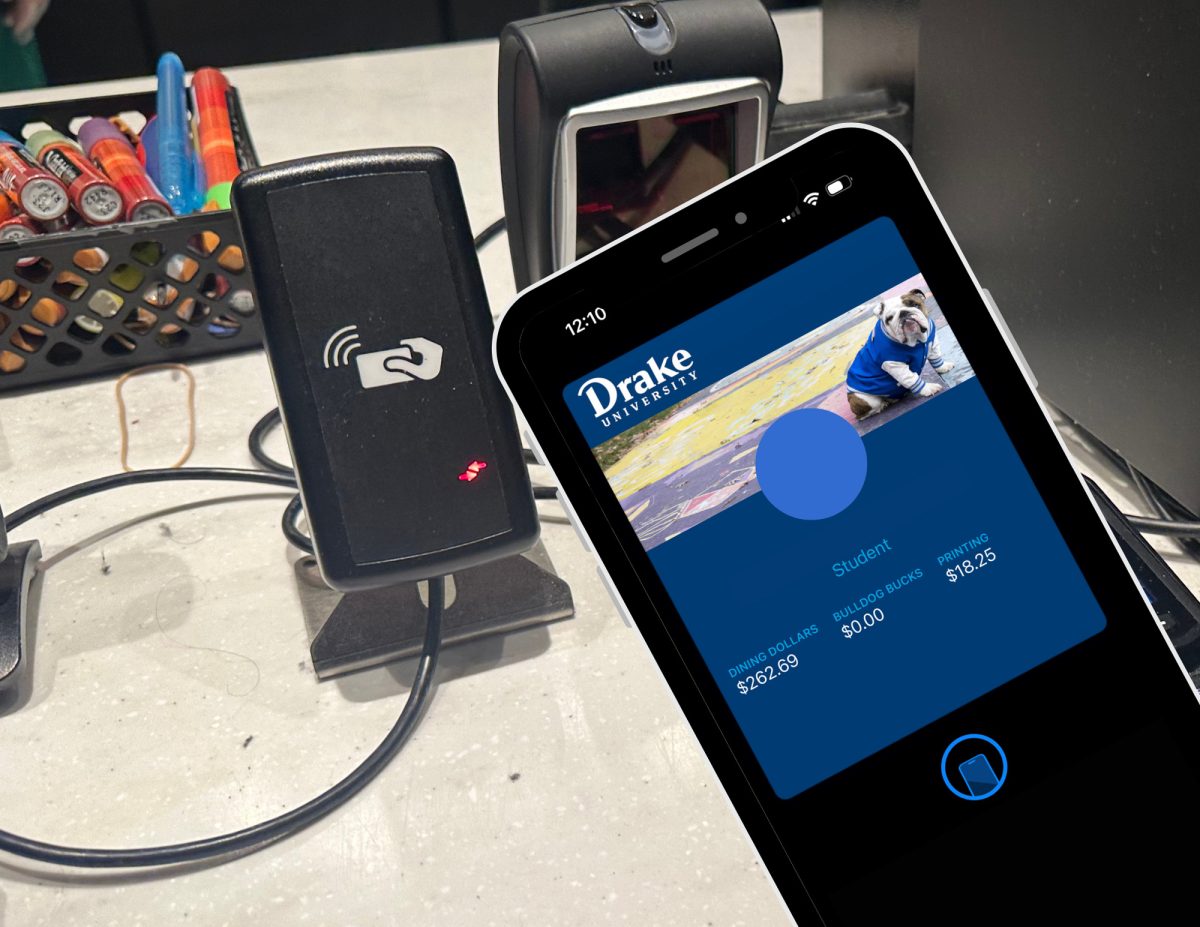When Drake University first transitioned to a card access system on campus, Executive Director of Public Safety and University Operations Scott Law saw mobile credentials as a next step. Over the past eight years, the University has monitored budget and technology developments and began discussing integrating the project in spring 2022.
Mobile credentials are phone-based IDs that can be accessed through the Transact eAccounts app and Apple Wallet. This year, first-years were not given physical IDs, except in special circumstances, and only use mobile credentials. Other years are able to opt-in.
“Although we want Drake to be on the cutting edge of what’s available to our students, faculty and staff, we didn’t want to be the guinea pig,” Law said. “We kind of let a little bit of time go by. The company we work with, Transact, worked [out] some of the bugs they were having with initial rollouts.
After a testing period in 2023, the campus-wide rollout of mobile credentials started in January 2024. Information Technology Services’ last check of numbers had over 3,100 individual active users on campus, which is a higher adoption rate than initially expected, said Technical Project Manager in ITS Jeff Regan.
“The incoming [first-year] class for this current fall, the standard process for them was to go to mobile ID, only printing a physical card if absolute [necessary], if they don’t have a mobile device that can handle it,” Regan said. “Our initial rollout, we leveled out right around 2,200 users in the first eight weeks.”
Overall, the rollout process has received positive feedback so far, Regan said. He spent time in Hubbell Dining Hall collecting student feedback, and he said he heard positive feedback regarding the usage of mobile credentials in residence halls and dining facilities. Law noted the ease of printing as an area that has received positive feedback as well.
“Once we were live, we switched to collecting any issues via the Service Portal for ITS,” Regan said. “If there were issues or people had questions, they were submitting them through there through a card ID issue request.”
One area of improvement for incoming first-years is entering their ID photo into the system. All users must upload a photo to the app before they are allowed to access their mobile ID. According to Law, the size of the pictures was limited for some people, and their photos were getting bounced back without them realizing it.
“We’re probably going to offer students the right to have their picture taken as part of their orientation,” Law said. “They’ll always have the ability to change it afterwards, but that way, they’ll know they’re set up [and] ready to go, and then if they’d like to change their picture at a later date, it’s simply a submittal process to get it changed.”
There are a limited number of phone types that do not support the mobile credentials, Regan said. Sophomore Abby Krozel encountered this issue and was unable to install her ID on her Motorola phone. As a result, she still uses a physical ID.
“I tried to get it on my phone, and it didn’t work,” Krozel said. “So I went to my friends and I asked how they did it, and they gave me some helpful tips, but that didn’t work either. So I went to the IT department, and they told me that my phone just does not support it.”
This is an issue with the device not supporting the mobile credential technology, Regan said. It will not be possible to expand the mobile credentials to include these types of phones.
“It had nothing to do with our technology,” Regan said. “It’s a phone model that doesn’t include an NFC [near-field communication] chip at all, and it’s a design by the manufacturer. It wouldn’t have worked with paying through the phone or any of those kinds of technologies. It was intentionally not included in those phone models, usually by the manufacturer as a cost reduction.”
Krozel said she wishes she was able to access the mobile credentials because of how convenient they would be. She once went to an event where she forgot her ID and wished she had it on her phone to avoid getting locked out of the residence halls.
“It would be helpful to have it on my phone because I always carry my phone,” Krozel said.
As for students and faculty who need printed ID cards, those will be provided as requested. However, the machine that is used to print ID cards is living on a “day-to-day basis,” Law said. Arrangements were made with Transact to produce physical IDs for those who need them on a bi-weekly or monthly basis once the machine is no longer functional.
“Since January of 2024, we have produced less than 100 actual ID cards, and the vast majority of those were created for special user groups this summer that are not truly Drake students, faculty or staff. They were here for a short time, so it would not have made sense to partition them into our ID system,” Law said.
Looking forward, Drake will continue to monitor new technologies, Law said.
“There [are] technologies out there to allow us to put card access on every single bedroom door on the campus,” Law said. “So keeping an eye on those technologies, seeing how they work and [asking], ‘Is it the right fit for Drake at this time?’”








